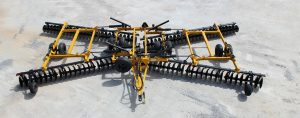Did you know?
Cover crop “cocktails” can provide a range of benefits, from weed suppression to nitrogen. Read more about cover crop benefits below.

Create the perfect seedbed with the F15 Double Offset Flexwing Tandem Disc Harrow
AMCO’s F15 Double Offset Flexwing Tandem Disc Harrow is a heavy-duty tool for primary tillage applications. It features folding wings that flex and follow the contour of the field. The double offset tandem design effortlessly smooths the soil to create the perfect, berm-free seedbed.
Read about how the F15 can help with cover crop management below.
For more photos and information on the F15, visit our website.
Features include :
- Protect-O-Shield® triple-lip sealed, greaseable ball-type, toggle-mounted bearings to eliminate blown seals and damage caused by wrap
- DIAL-A-DEPTH to allow an even cut with positive depth control over the entire width of the harrow
- Main frames featuring boxed, all-welded steel tubing
- An adjustable clevis of ductile iron that fits all tractor hitches
- Scrapers have high-carbon replaceable blades on heavy-duty shanks, mounted with grade 5 bolts on high-grade angle iron bars
Optional features include:
- Heavy-duty wheels, heavy-duty scrapers, and cutout blades in place of standard blades
Upgraded scraper system ideal for wet conditions is available on F15 Heavy Duty models
Try out a cover crop cocktail that suits your needs
In many parts of the U.S., cover crops are becoming more and more popular. Skeptical? A 2013 Farm Journal study showed that of 1,700 farmers asked, 60% had at some time planted a cover crop. Not just in the Midwest, either, but throughout the South and Eastern U.S.[i]
With the range of benefits cover crops can offer, it’s easy to see why. Erosion control, increased soil moisture, lower fertilizer costs, pest and weed prevention, alleviating soil compaction—a specific cover crop is often chosen to provide help where a farm most needs it, such as tillage radish to relieve soil compaction. Some farmers plant a “cocktail” of cover crops to take advantage of several of these benefits.
For example, an Arkansas farmer has used a mix of cereal rye and radishes for years. Benefits include deep tillage of soil, increased water penetration, reduced soil and wind erosion, and, most recently, helping manage two glyphosate-resistant weeds, horseweed (marestail) and Palmer amaranth (pigweed). A cover crop that is established in the field before the weeds come up helps suppress weed growth.[ii]
Farmers looking for the immediate economic benefit of cover crops should consider cover crops that can reduce the need for nitrogen application. According to the Mississippi State University Agricultural Extension, cover crop legumes like clovers and vetches accumulate nitrogen, which is then released after the cover crop is killed and decomposes.[iii] More nitrogen available to crops equals lower input costs and increased yields for the primary crop.
Like all farming, cover crops require careful management: the right combination of cover crop and cash crop must be chosen, the cover crop must be planted at the right time, and it must be terminated properly so it doesn’t become a weed. The National Resources Conservation Service provides guidelines for planting and termination. If you want to learn more about what cover crops might work well with your operation, plan to attend the 2014 Southern Agricultural Cover Crops Conference on Oct. 28-29 at the Arkansas State University Convocation Center in Jonesboro, Arkansas.
AMCO also offers equipment to help properly manage cover crops. After harvesting the primary crop, farmers can mulch up the soil with equipment like AMCO’s F15 Double Offset Flexwing Tandem Disc Harrow in order to let residue decompose. Cover crops can then be planted on top of the residue. In the spring, the disc is run over the cover crop residue, creating a perfect seedbed before the primary crop is planted.
[i] https://www.agweb.com/article/cover_crops_swing_into_popularity_NAA_Sara_Schafer/
[ii] http://deltafarmpress.com/management/producers-harness-cover-crops-suppress-weeds
[iii] http://msucares.com/news/print/agnews/an12/120913_cover_crop.html